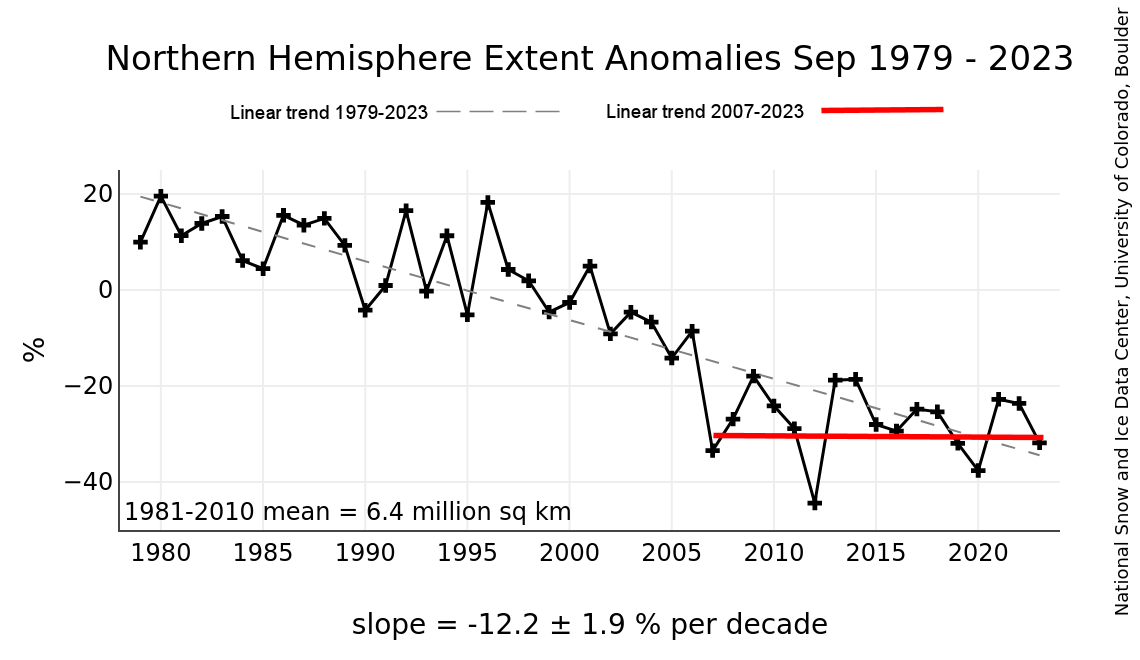Key Takeaways:
- Arctic sea ice melts and refreezes every year, typically peaking in March, while the summer minimum typically occurs in September.2
- Many scientists, politicians, and media sources wrongly predicted Arctic sea ice would disappear in the summer.
- Satellite data show the summer minimum sea ice has not decreased at all since 2007, and instead has formed a stable level after a temporary low in 2012.
Short Summary:
Consistent and comprehensive measurement of Arctic sea ice has only occurred since 1979 through the use of satellites. Proxy data and historical records indicate that Arctic sea ice waxes and wanes from year to year and decade to decade. The National Snow and Ice Data Center (NSIDC) examined these lines of evidence and concluded, “Arctic sea ice may have melted completely in summertime about 125,000 years ago, during a warm period between glaciations. As recently as 5,500 years ago, summertime Arctic sea ice may have been much less extensive than it is today.”3
Satellite data showing a decline in Arctic sea ice has been wrongly used by scientists, politicians, and media, as an indicator of climate change. Because of an abrupt drop in 2007 in the summer minimum sea ice extent, claims of imminent “ice-free summers” in the Arctic were common. For example, in 2008 NSIDC scientist Mark Serreze told ABC News that the Arctic could be “ice free” that summer.4 In 2009, Al Gore said “the North Pole will be ice-free in the summer by 2013 because of man-made global warming.”5
However, data in Figure 1 from the NSDIC show none of these predictions came true.6
Figure 1. Shows satellite derived summer minimum Arctic Sea ice extent values from 1979 to 2023, with dashed line showing the linear trend. The added trend line in red shows no change in summer minimum extent since 2007. Image source: NSIDC. Red trend line from 2007 and trend line examples under the title added by A. Watts
The sea ice minimum in September 2023 was essentially the same as it was in 2007, when all the predictions of “ice free summers” began. Moreover, data from 2007 to 2023 show a zero net-change over the past 17 years. The flat trend from 2007 to 2023 suggest a regime shift in the Arctic sea ice system to a new stable level.7, 8
There is precedence for such a pattern of ice drop. The May 1, 1931 issue of Monthly Weather Review quoted a report from the Danish Meteorological Institute noting “extraordinarily little ice” in the Barents Sea, and “around Spitsbergen open water was more extensive than in any other year during this century.”9 This occurred well before modern claims of man-made climate change affecting Arctic sea ice.
References:
- NASA Scientific Visualization Studio, Arctic sea Ice Maximum 2023, March 15th, 2023, accessed 10/28/23, https://svs.gsfc.nasa.gov/5091/
- NASA Earth Observatory, World of Change: Arctic Sea Ice, accessed 10/17/23, https://earthobservatory.nasa.gov/world-of-change/sea-ice-arctic
- National Snow and Ice Data Center, How was Arctic sea ice measured before the satellite era?, October 27, 2020, accessed 11/5/23, https://nsidc.org/learn/ask-scientist/how-was-arctic-sea-ice-measured-satellite-era
- ABC News, North Pole Could Be Ice Free in 2008, accessed 10/30/23, https://abcnews.go.com/Technology/story?id=4728737&page=1
- Politifact, The Poynter Institute, Fact-checking claims that Al Gore said all Arctic ice will be gone in the summer by 2013, accessed 10/30/23, https://www.politifact.com/factchecks/2021/mar/02/facebook-posts/fact-checking-claims-al-gore-said-all-arctic-ice-w/
- National Snow and Ice Data Center, Sea Ice Index Daily and Monthly Image Viewer, accessed 11/01/23, https://nsidc.org/data/seaice_index and https://nsidc.org/data/seaice_index/images/n_plot_hires.png
- Wikipedia, Regime shift, accessed 10/31/23, https://en.wikipedia.org/wiki/Regime_shift
- Sumata, H., de Steur, L., Divine, D.V. et al. Regime shift in Arctic Ocean sea ice thickness. Nature 615, 443–449 (2023), accessed 11/01/23, https://doi.org/10.1038/s41586-022-05686-x
- American Meteorological Society, Monthly Weather Review, May1, 1931, accessed 11/09/23, https://doi.org/10.1175/1520-0493(1931)59<202c:IITAS>2.0.CO;2 and PDF at https://journals.ametsoc.org/downloadpdf/journals/mwre/59/5/1520-0493_1931_59_202c_iitas_2_0_co_2.xml
Climate At A Glance is a Project of The Heartland Institute
Email: think@heartland.org
Image above: Arctic sea ice maximum, March 6, 2023. Image from NASA Scientific Visualization Studio.1
View this page as a printable PDF file here: Climate at a Glance – Arctic Sea Ice



